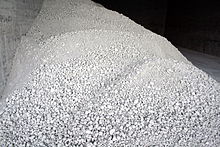Crockery

Clay ware is the name for a group of ceramic masses in which the shards of the products or objects produced do not sinter during the firing process and are therefore unglazed and water-permeable.
| Class: Earthenware | Subclass: other earthenware | Group: Pottery | Subgroup 1: Unglazed ceramics Subgroup 2: glazed ceramics |
Manufacturing
Clay ware usually consists of clay , quartz , feldspar and, if necessary, stabilizing emaciation and other admixtures.
The firing temperature is lower than that of sintered ware (900–1,100 ° C), so the body cannot sinter and, unlike stoneware and porcelain, is not waterproof. In order to still produce waterproof ceramics , glaze must be applied and fired.
properties
Pottery is not translucent, crystallized body that is porous, hard and solid. It is unglazed and permeable to water.
use
Pottery is one of the oldest ceramics and is still in great demand and popularity thanks to its properties similar to porcelain .
The most famous products of this group are:
- Unglazed ceramics subgroup: terracotta
- Glazed ceramics subgroup: majolica , faience and frit porcelain which are also known as semi-porcelain.
Individual evidence
- ^ Allen Dinsdale: Pottery Science: Materials, Process and Products . Ellis Horwood Limited, 1986.
- ↑ See also: Classification of ceramic bodies
- ↑ Brockhaus , Volume 11. ISBN 3-7653-3671-8 , p. 644.
